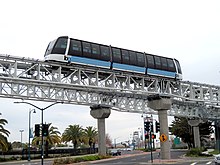
Back Osobní dopravník Czech Peoplemover German Homtransportilo Esperanto Transporte hectométrico Spanish Anezka tren Basque Navette automatique French מסיעון HE लोग प्रस्तावक Hindi Angkutan penggerak massa ID People mover Italian
This article needs additional citations for verification. (August 2014) |

| Automated track-bound traffic |
|---|
| Automatic train operation |
| Lists of automated train systems |
| Related topics |

A people mover or automated people mover (APM) is a type of small scale automated guideway transit system. The term is generally used only to describe systems serving relatively small areas such as airports, downtown districts or theme parks.
The term was originally applied to three different systems, developed roughly at the same time. One was Skybus, an automated mass transit system prototyped by the Westinghouse Electric Corporation beginning in 1964.[1][2][3] The second, alternately called the People Mover and Minirail, opened in Montreal at Expo 67. Finally the last, called PeopleMover or WEDway PeopleMover, was an attraction that was originally presented by Goodyear Tire and Rubber Company and that opened at Disneyland in 1967.[4] Now, however, the term "people mover" is generic, and may use technologies such as monorail, rail tracks or maglev. Propulsion may involve conventional on-board electric motors, linear motors or cable traction.
Generally speaking, larger APMs are referred to by other names. The most generic is "automated guideway transit", which encompasses any automated system regardless of size. Some complex APMs deploy fleets of small vehicles over a track network with off-line stations, and supply near non-stop service to passengers. These taxi-like systems are more usually referred to as personal rapid transit (PRT). Larger systems, with vehicles with 20 to 40 passengers, are sometimes referred to as "group rapid transit" (GRT), although this term is not particularly common. Other complex APMs have similar characteristics to rapid transit systems, and there is no clear cut distinction between a complex APM of this type and an automated mass transit system. Another term "light metro" is also applied to describe the system worldwide.[5][6][7]
- ^ "Skybus in Pittsburgh". Archived from the original on 2010-02-10. Retrieved 2010-04-17.
- ^ Massey, Steve. "Who killed Westinghouse?". Pittsburgh Post-Gazette. Archived from the original on 2007-11-17. Retrieved 2007-11-12.
- ^ "Westinghouse Company Timeline (1940–1979)". Westinghouse Electric Company, LLC. Archived from the original on 2007-08-19. Retrieved 2007-11-12.
- ^ Weiss, Werner. "PeopleMover at Disneyland". Yesterland.com. Archived from the original on 2007-11-07. Retrieved 2007-11-12.
- ^ Michael Taplin (March 2013). "A world of trams and urban transit - A complete listing of Light Rail, Light Railway, Tramway & Metro systems throughout the World". Light Rail Transit Association (LRTA). Archived from the original on 2007-10-08. Retrieved 2014-11-28.
- ^ "Korean city opens automatic light metro". Rail Journal.com. 2 July 2012. Archived from the original on 2014-11-06. Retrieved 2014-11-24.
- ^ "BJP promises light metro in Bhopal and Indore". dnaindia.com. Archived from the original on 2014-12-05. Retrieved 2014-11-28.